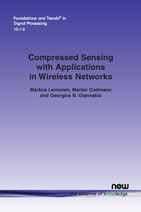Compressed Sensing with Applications in Wireless Networks
By Markus Leinonen, University of Oulu, Finland, markus.leinonen@oulu.fi | Marian Codreanu, Linköping University, Sweden, marian.codreanu@liu.se | Georgios B. Giannakis, University of Minnesota, USA, georgios@umn.edu
Abstract
Sparsity is an attribute present in a myriad of natural signals and systems, occurring either inherently or after a suitable projection. Such signals with lots of zeros possess minimal degrees of freedom and are thus attractive from an implementation perspective in wireless networks. While sparsity has appeared for decades in various mathematical fields, the emergence of compressed sensing (CS) – the joint sampling and compression paradigm – in 2006 gave rise to plethora of novel communication designs that can efficiently exploit sparsity. In this monograph, we review several CS frameworks where sparsity is exploited to improve the quality of signal reconstruction/detection while reducing the use of radio and energy resources by decreasing, e.g., the sampling rate, transmission rate, and number of computations. The first part focuses on several advanced CS signal reconstruction techniques along with wireless applications. The second part deals with efficient data gathering and lossy compression techniques in wireless sensor networks. Finally, the third part addresses CS-driven designs for spectrum sensing and multi-user detection for cognitive and wireless communications.
Compressed Sensing with Applications in Wireless Networks
Many natural signals possess only a few degrees of freedom. For instance, the occupied radio spectrum may be intermittently concentrated to only a few frequency bands of the system bandwidth. This special structural feature – signal sparsity – is conducive in designing efficient signal processing techniques for wireless networks. In particular, the signal sparsity can be leveraged by the recently emerged joint sampling and compression paradigm, compressed sensing (CS).
This monograph reviews several recent CS advancements in wireless networks with an aim to improve the quality of signal reconstruction or detection while reducing the use of energy, radio, and computation resources. The monograph covers a diversity of compressive data reconstruction, gathering, and detection frameworks in cellular, cognitive, and wireless sensor networking systems.
The monograph first gives an overview of the principles of CS for the readers unfamiliar with the topic. For the researchers knowledgeable in CS, the monograph provides in-depth reviews of several interesting CS advancements in designing tailored CS reconstruction techniques for wireless applications. The monograph can serve as a basis for the researchers intended to start working in the field, and altogether, lays a foundation for further research in the covered areas.
